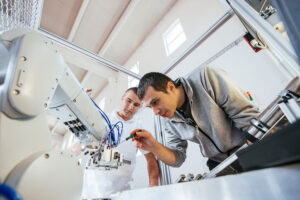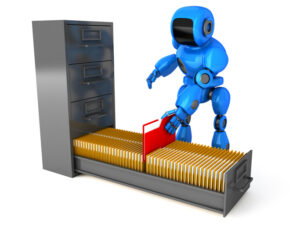Written by Scott Wilson

Robots have captured the imagination of the public in a way that no other kind of artificial intelligence has managed. For generations now, sentient droids have been such a mainstay of popular science fiction that we’re as cozy with non-human characters as we are with any other. And since virtually all are depicted as loyal assistants whose only purpose is to selflessly serve, in some ways our affinity for them may be even stronger.
There’s something about a kind of intelligence that can reach out and touch the same reality that we do. Even automation systems that shuffle papers or respond to emails seem like a little bit of magic. And they will play an important role in making AI into something that has a real impact in our society.
When there is an AI robots press conference at a UN AI summit, you know the field of robotics has hit the big time.
That makes the field of automation and robotics a crucial one in artificial intelligence. When most people around the world first encounter real, functioning AI, it will be through one of these systems. There’s a lot of pressure to get it right.





Why AI Robots for Sale Mostly Made in the Image of Humans
 When most people think about artificial intelligence, they tend to think of it in human form. Robots offer a familiar and understandable focal point. When we anthropomorphize machine intelligence, it’s just easier to get a grip on when it takes a form that mimics what we are familiar with.
When most people think about artificial intelligence, they tend to think of it in human form. Robots offer a familiar and understandable focal point. When we anthropomorphize machine intelligence, it’s just easier to get a grip on when it takes a form that mimics what we are familiar with.
I believe that robots should only have faces if they truly need them.
~ Dr. Donald Norman, designer and advocate for cognitive systems engineering
There’s no reason AI robotics must stick with the humanoid form. Robots can be optimized for hundreds of tasks that the human body is actually pretty bad at.
- Search and rescue robots have been built to resemble snakes, able to squeeze into tight spaces in collapsed buildings to use sensitive infrared and audio sensors to detect signs of life that a human couldn’t
- Industrial robots are built with limited range of motion but robustly to perform highly repetitive tasks like welding far more safely and quickly than a full bipedal frame could manage
- Wheeled and propeller-equipped drones can move far faster over all kinds of terrain or even fly, a tough trick for the typical biped
- Multi-legged robots also come with terrain and stability advantages that bipeds can’t manage
On the other hand, it’s a bit too soon to write off the human form. The adaptability of our humble bipedal stance has made us masters of the planet. While there are plenty of things that other creatures are better at than we are, we have proven more capable of adjusting to more environments and tasks than any other creature. AI humanoid robots could exploit many of the same advantages.
What Is AI in Robotics? – AI Robotic and Automation Applications
 Robotics is a fairly old field in comparison to most of the technologies and tools used in artificial intelligence. It even predates the invention of the digital computer.
Robotics is a fairly old field in comparison to most of the technologies and tools used in artificial intelligence. It even predates the invention of the digital computer.
Early robots managed to do that by using entirely mechanical systems for command and control. In the 1920s, a mechanical robot called Elektro was able to walk, smoke cigarettes, and blow up balloons. It had a robot dog companion called Sparko that could bark, sit, and beg on command.
Analog electronics were quickly adopted to provide more processing capability. Even as digital computers were making a splash in the business world, early versions proved too fragile to use for many physical tasks in the industrial world where early robots found a home. Quickly adopted in factories for difficult or dangerous tasks, these were a big part of the rebuilding of industry in post-war Germany and Japan.
Roughly half of all robots in the world are in Asia, with a full 40 percent in Japan alone.
But no one would associate those robots with artificial intelligence. They were workhorses, built for hard use and simple, repetitive tasks. While they were eventually switched over to logic systems powered by digital chips, the programming remained straightforward. Even when combined with tools like machine vision, there was no concept of reasoning ability or problem-solving in the systems.
Building Robot AI Turned Out to Be More Difficult Than Expected
 Yet the potential for revolutionary new uses powered by better brains was clear. Even early on, industrial users dreamed of robots that could take on more complex tasks with less supervision.
Yet the potential for revolutionary new uses powered by better brains was clear. Even early on, industrial users dreamed of robots that could take on more complex tasks with less supervision.
Those tasks could be surprisingly complex, though. Take the common and apparently straightforward job of loading a shipping container.
Right away, you run into mobility requirements. Depending on the size and weight of the goods, the ‘bot may have to deal with tricking footing or reaching tasks. It has to navigate in and out of the container and to the warehouse, identifying the right packages and retrieving them. It may have to take in other considerations, like unloading order, and delicacy.
Putting the box of Kleenex in the container above the package of barbells is a no-brainer for humans, but not necessarily for robots.
And it must use the space with optimal efficiency, with no big gaps. But suddenly you’ve blundered into the bin packing problem, a challenge that routinely makes the list of the most computationally difficult of equations. A human can easily shoot for a compromise that is sub-optimal but doesn’t take too much time to complete. An AI robot needs sophisticated reasoning skills to do anything like that.
What Is AI Automation?
 Automation and robotics are closely connected and often overlap. But automation doesn’t necessarily involve any physical components. Instead, it’s simply the ability of AI to replicate certain real-world processes otherwise performed by humans.
Automation and robotics are closely connected and often overlap. But automation doesn’t necessarily involve any physical components. Instead, it’s simply the ability of AI to replicate certain real-world processes otherwise performed by humans.
In that sense, automation has been a powerful component of the information technology industry for a long time. It’s the software version of industrial robots. Big companies seeking efficiency have been tapping into digital systems to automate features such as:
- Document processing and handling
- Scraping data from non-standard formats into database files
- Creating automated email systems to handle multi-step processes
- Appointment scheduling
- Appointment scheduling
- Claims and loan processing
Sometimes, automation and robotics are combined. Automated document scanners that feed pages through optical character recognition to create digital copies and then file them appropriately are one example.
In the future, AI may be able to automate any process that human staff currently perform.
In the same ways that robotics benefit from AI, so does automation in general. The more capable an automation system is of applying classification and reasoning, the more tasks it can take off a human employee’s plate.
And so AI has made some of the same inroads into process automation as it has in industrial robotics. Where form automation systems were once coded simply as lengthy if-then decision trees, today they may be built with a tool like Microsoft’s AI Builder in Power Automate Desktop RPA. Using no-code model generation based on pre-built language models, workflow and application automation can take on new capabilities in recognizing text, processing invoices, invoking sentiment analysis, or responding to email.
AI Robots and Automation Will Drop Machine Intelligence into Reality
AI in automation and robotics is about putting artificial intelligence to use in the real world.
It’s a machine. It doesn’t get happy. It doesn’t get sad. It doesn’t laugh at your jokes. It just runs programs.
~ Steve Gutenberg, Short Circuit
Some of the other essential technologies in AI, like deep learning or computer vision, are foundational. They are on the critical path to build many other types of artificial intelligence across industries and domains.
Chatbots are fun, but they will never have the visceral impact of a moving machine that works independently of human instruction.
Automation and robotics are a little different. Although it’s also a technology with a wide range of potential uses, it’s where AI really becomes a breathing, participating part of the world we live in. AI with robotic hands can have agency. It will get things done. It will interact on a real, physical level with humanity.
It’s where AI has always been headed. And it’s where some of the real changes in society will come from.
AI Automation in Healthcare Biomedical and Surgical Robotics
 As anyone who has ever worked in healthcare can tell you, clinicians can spend as long dealing with paperwork as they do with patients. Even in an age of electronic charting and EHR (electronic healthcare records), there is a lot of document processing going on. AI automation is already scanning, recognizing, and cataloging old paperwork. And it’s being used increasingly to stand in for human customer service, billing, and scheduling representatives.
As anyone who has ever worked in healthcare can tell you, clinicians can spend as long dealing with paperwork as they do with patients. Even in an age of electronic charting and EHR (electronic healthcare records), there is a lot of document processing going on. AI automation is already scanning, recognizing, and cataloging old paperwork. And it’s being used increasingly to stand in for human customer service, billing, and scheduling representatives.
But paperwork isn’t the only thing healthcare robots will be getting their hands on. Surgical robots are being developed to work with human surgeons. They never have to worry about shaky hands and can be deployed and operated in remote locations where human surgeons aren’t available.
AI in Automation
General automation is a big field for many different businesses and industries. Just as automation can pitch-in on medical record processing, it can potentially handle almost any kind of paperwork retrieval, filing, and sorting with the right AI behind it.
Automation AI is already being used to punch up existing corporate automation systems through RPA (Robotic Process Automation). By throwing cognitive skills into current digital automation systems, they can become more autonomous and more capable. AI can even be used to train automation processes by simply watching humans as they perform the task.
AI in Test Automation
In a complex, high-tech society, there are an astounding number of things that need to be tested robustly and comprehensively. From new iPhone apps to airplane door plugs, getting testing and quality assurance right is a built-in expense for most industries.
It’s a process that is itself fallible, however. Human testers get bored, or have failures of the imagination, or tire out as they perform repetitive tasks.
AI in automation testing can be used to create testing processes that never get bored, never get tired, and don’t ever ask for a raise. Better yet, they can learn as they go and update processes automatically, leaving fewer gaps for quality and safety issues to slip through.
AI in Aerospace Robotics
Autopilot systems are common in aircraft of all types and sizes, but they are a far cry from artificial intelligence.
That’s all changing with the world of drone aviation. While most drones today are still commanded in real-time, they are already doing a lot of work in maintaining stability, orientation, and flight modes without active input. Fully autonomous autopilots will allow them to range further and with less oversight… and will certainly migrate to crewed aircraft to reduce pilot workload and increase safety.
Outer Space Is the Perfect Use Case for AI Robots
 If ever there were an area where robots hold a natural advantage over human beings, it’s in space.
If ever there were an area where robots hold a natural advantage over human beings, it’s in space.
The rigors of a hard vacuum, extremes of heat and cold, and no natural resources for support make space a hard lift for human explorers.
But it’s a day at the spa for robots. No corrosive oxygen, plenty of sunshine for power, and no pesky humans within thousands of miles.
That last bit is the challenge, though. And it’s where AI can completely revolutionize space exploration.
Traditional robots, even the advanced Mars rovers like Perseverance and Curiosity, have very limited logic. They use computer chips that date back to the candy-colored iMac era and have one tenth the memory capacity of the cell phone in your pocket. Yet they must operate independent of human oversight. Grainy video and a light-speed time leg measured in minutes if not hours means ground control can offer limited help.
AI has been key to pathfinding and autonomous driving across the rocky terrain. That, in turn, has required better computer vision and image processing software and sophisticated terrain analysis. It is also being used to give the rovers more agency in their science mission… a new system called AEGIS allows Curiosity to pick its own target objects for laser analysis.
Agencies and organizations that design spacecraft are going all-in on AI robotics for everything from managing distant missions to asteroids to building durable hardware for satellites.
AI in Industrial Automation and Electrical and Systems Engineering
 As already noted, the existing families of robots built for industrial and manufacturing uses are getting a big upgrade in autonomy from artificial intelligence. The field is also expanding robot capabilities, introducing mobile robots that can shoulder a heavy load on construction sites.
As already noted, the existing families of robots built for industrial and manufacturing uses are getting a big upgrade in autonomy from artificial intelligence. The field is also expanding robot capabilities, introducing mobile robots that can shoulder a heavy load on construction sites.
Robotics also has a role to play in electrical and control systems engineering. Complex control systems are tough for humans to manage. Keeping track of dozens or hundreds of sensor inputs and processes isn’t what we’re built for. But robotics systems are a perfect fit for managing control systems, using reasoning skills and lightning quick calculation to make better decisions and take the load off human operators.
AI in Marketing Automation
Leave it to the business world to put AI to work in selling things to people. Marketing automation raked in around $94 billion in 2021 according to Forbes magazine, going toward systems that gather data on customers, analyze their wants and needs, and individually tailor campaigns to personalize offers and send unique email chains to pursue them. A third of marketers are already boosting their outreach systems with AI marketing automation.
Sophia, an AI robot that has been granted citizenship in Saudi Arabia, is primarily used for marketing appearances, promoting tourism in Abu Dhabi, a European credit card, and a video game… about robots.
What Kinds of Systems Do Robot AI Projects Require?
This puts AI robotics challenges in a unique category. It can require expertise in specialized fields ranging from embedded systems programming to vascular surgery.
To build machines with all those various capabilities, roboticists will tap into all those various other techniques:
- Computer Vision - To interpret, understand, and interact with surroundings
- Natural Language Processing - To hear commands and to reply in understandable language
- Deep Learning and Neural Networks - To develop problem-solving skills necessary to move around in and manipulate the environment
On top of the artificial intelligence aspects of building intelligent robots, there are several other fields that must be mastered for AI robotics:
- Locomotion - While some robots are perfectly useful sitting in one place, like industrial assembly line welders, most can only get things done with an ability to move around. Wheels are a clear solution for some kinds of robots, but others need more flexibility. Legs are pretty all-purpose, but it’s a surprisingly difficult thing to coordinate and steer any kind of device with a bunch of appendages flailing around underneath. And in every case, robots have to be able to navigate safely to and from wherever it is they need to be. Pathfinding, safe movement, and stability open up a bunch of challenges, from assessing ground and floor material to classic object avoidance issues.
- Manipulation - Just rolling around is only useful for a specific class of AI robots. Others need the ability to interact with their environment. That means grippers, tools, levers, and digits of all kinds. Each comes with advantages and disadvantages. Many present challenges of material engineering—finding a coating that can get a grip in various weather conditions but not wear away rapidly, for instance. And the mechanical challenges of building joints and understanding degrees of motion present real issues as well.
- Sensory technology - Feeding computer vision routines, for starters, requires cameras. But sight alone isn’t enough for humans to get by in the real world. So robots will need other senses to tell them about the world: accelerometers to sense motion, audio to hear speech, thermometers to gauge temperature, vibration sensors and gyroscopes to assess stability. Each of these is a technical specialty in its own right. They must be blended together, in some cases dealing with conflicts they create with one another. And then they must be integrated into the overall reasoning and control systems to govern the machine’s actions.
- Safety - Underlying all the other challenges in robotics is the safety angle. When you put autonomous decision-making devices out in the world teeming with unpredictable, fragile human beings, there’s massive potential for people to get hurt—and for robots to get destroyed. Much of the work of AI robotics engineers is in developing systems to ensure that robot operation is safe for the robots and for people. And, at a slightly lower level, they work to build systems where robots and humans can safely and predictably work with one another instead of getting in each other’s way.

The First Law: A robot may not injure a human being or, through inaction, allow a human being to come to harm.
The Second Law: A robot must obey the orders given it by human beings except where such orders would conflict with the First Law.
The Third Law: A robot must protect its own existence as long as such protection does not conflict with the First or Second Law.
~ The Three Laws of Robotics, proposed by science fiction author Isaac Asimov
These are all practical engineering issues that AI robots have to overcome. And unlike software-based AI, the practical consequences of getting it wrong in robotics can be costly… even fatal.
Even When Robots Are Safer Than Humans, They Are Held to Higher Standards
 Whether it’s just fear of the unknown or some new robot-centered phenomena, people seem to be more scared of AI robots even when robots are safer than people.
Whether it’s just fear of the unknown or some new robot-centered phenomena, people seem to be more scared of AI robots even when robots are safer than people.
This comes up most often today in the context of self-driving vehicles.
Decades of crash data from the National Highway Traffic Safety Administration has shown that over 90 percent of accidents in the U.S. are a result of driver error. While the depth of data isn’t nearly as good for self-driving vehicles, so far, on a mile-per-mile basis, they experience far fewer crashes than human-driven vehicles. And in many cases, those collisions were found to be the fault of the human driving the other vehicle involved.
The well-known case of the pedestrian killed in Arizona by self-driving Uber test vehicle is a case in point. The car’s built-in emergency braking system detected the pedestrian with sufficient time to stop; but the system had been disabled in favor of relying on the safety driver, who was looking at her phone at the time.
Still, people are freaked out by the idea of fully robotic cars—even when people themselves are the biggest danger. Uber was forced to shut down their testing program after the accident.
It may be because when robotic vehicles make mistakes, they aren’t the sort of mistakes humans would make. While dangerous, human drivers are familiar and relatable. Robot AI transportation will have to overcome the gap to be accepted, even if it offers a life-saving opportunity to society.
No matter what area of AI robotics design and programming you turn to, it can seem like the challenges are a bottomless well. Everything unpacks into whole new areas of expertise, any of which can take a lifetime commitment of study and practice to master.
Artificial Intelligence Robotics Degrees Are the Place to Up-Skill Levels in AI Robot Design
 With such a unique blend of material robotics skills and underlying artificial intelligence ability, AI robotics is a field that has come to count on specialized degrees for education.
With such a unique blend of material robotics skills and underlying artificial intelligence ability, AI robotics is a field that has come to count on specialized degrees for education.
While many AI degree programs are rooted in university computer science departments, those run by the department of engineering may be more aimed toward robotics and automation education. A Master’s in Robotics and Autonomous Systems is one example. But there are also Master of Science in Engineering (MSE) in Robotics with AI and Machine Learning specialization and Master of Science in AI Robotics concentration degrees that fit the bill.
And both engineering and computer science schools may offer something along the lines of a Master of Science in Computer Science Robotics specialization or a Master of Science in Artificial Intelligence with a concentration in Robotics and Automation that will cover similar territory.
AI is so clearly the future of the field that even programs that were once more focused on industrial robotics have transitioned to teaching autonomous systems coursework.
Degree programs in industrial engineering are starting to offer smart manufacturing industrial informatics options, or automation and control systems tracks that verge into AI territory.
If robots are to clean our homes, they'll have to do it better than a person.
~ James Dyson
Because robotics is also a field that is relatively well-established, there are more undergraduate programs available than in more cutting-edge AI fields. While advanced programs are still the norm for researchers and advanced developers, there are many positions in robotics that come down to dealing with practical challenges in the workplace. Setting up new systems, troubleshooting malfunctions, reprogramming, and similar tasks take a high level of skill, but not graduate-degree stuff.
A Bachelor of Applied Science in Robotics and Artificial Intelligence or a Bachelor of Science in Robotics and Autonomous Systems offers the specialized blend of courses that robotics technicians and programmers need, without the additional research or advanced design skills of graduate studies. Programs like a Bachelor of Applied Technology in Artificial Intelligence and Robotics come at the challenges from the other angle, diving into the AI aspects of robotics first.
There are also general degrees in computer science with a robotics focus, like a Bachelor of Science in Computer Science specialization in Artificial Intelligence and Robotics. These programs stay firmly grounded in computational instruction and cover AI and robotics topics in only a handful of classes, however.
AI Robotics and Automation Can Be Found on Three Tracks in the Artificial Intelligence Field
AI careers and education today are tending to line up along three kinds of tracks:
- Highly theoretical, research-focused positions that focus on developing core computational abilities and features
- Business-focused roles that look to develop applications for AI in specific use cases for corporations or governments
- Highly specialized functions in sensitive and deeply technical fields where AI can offer new capabilities and advances with careful integration
Robotics and automation tend to fall into the second two categories more than the first.
Business-focused AI robotics development revolves around taking off-the-shelf or well-understood robot technologies and integrating them into existing business operations for greater efficiency. These positions may be as much about understanding business cases and operations as robotics and AI. They benefit from a broader education and big picture understanding of society and economics.
Specialty robot AI takes a similar path to using autonomous robots to meet current real-world needs, but in fields that are highly complex or sensitive. These roles often require substantial domain expertise as well as AI robotics skills, or an ability to work closely with experts in those fields.
Also squarely on the industrial automation side of the family are a handful of associate degrees that will introduce you to the basics of automation and robotics. While these are mostly aimed at technicians maintaining assembly line and other robot installations, they can also give you a boost toward a full bachelor’s degree. The two-year course of study in an Associate in Robotics & Automation Technology or just an Associate in Robotics may be accepted as transfer learning toward a full four-year degree.
Robotics and Automation Offer a Range of Specializations

Many dedicated robotics majors offer further educational specializations or concentrations. With the complexity that comes with every aspect of putting together autonomous robots, focused education can be a good idea.
While there are many different areas of specialization, they tend to fall into one of two different categories.
Specializations that offer additional expertise in core challenges in robot AI development. These are the fields that can apply in almost any kind of use, but that benefit from additional training. They include concentrations like:
- Autonomous Systems
- Artificial Intelligence
- Dynamics, Navigation, Decision, and Control
- Perception and Cognitive Systems
- Human/Robot Interactions
Then there are specializations that revolve around robotics uses in various fields. These cover all the same core issues in robotics, but address them all from the perspective of uses in a particular kind of application. They can include:
- Biomedical Engineering
- Mechanical and Aerospace Engineering
- Electrical Engineering
- Systems Engineering
To a Great Extent, Future Uses of AI Will Center on AI and Robotics
 Automation and robotics are sure to be one of the hottest sub-fields within artificial intelligence work over the coming decades. As the area where the rubber meets the road, it’s one of the fields that can deliver the greatest economic benefits. That’s already true at current levels of AI technology. It’s only going to become more powerful as the state-of-the-art advances.
Automation and robotics are sure to be one of the hottest sub-fields within artificial intelligence work over the coming decades. As the area where the rubber meets the road, it’s one of the fields that can deliver the greatest economic benefits. That’s already true at current levels of AI technology. It’s only going to become more powerful as the state-of-the-art advances.
But it’s also going to be one of the areas with the biggest challenge in ethics and alignment. Working out alongside or around people brings up all kinds of questions. And it’s not always a case of protecting people from rampant AI. Tongue-in-cheek websites addressing the concept of robot abuse already exist, but they may be a lot less funny when more machines are in the wild.
The lightning progress of advances in computer vision, natural language processing, and deep neural networks are spurring AI roboticists forward every day.






